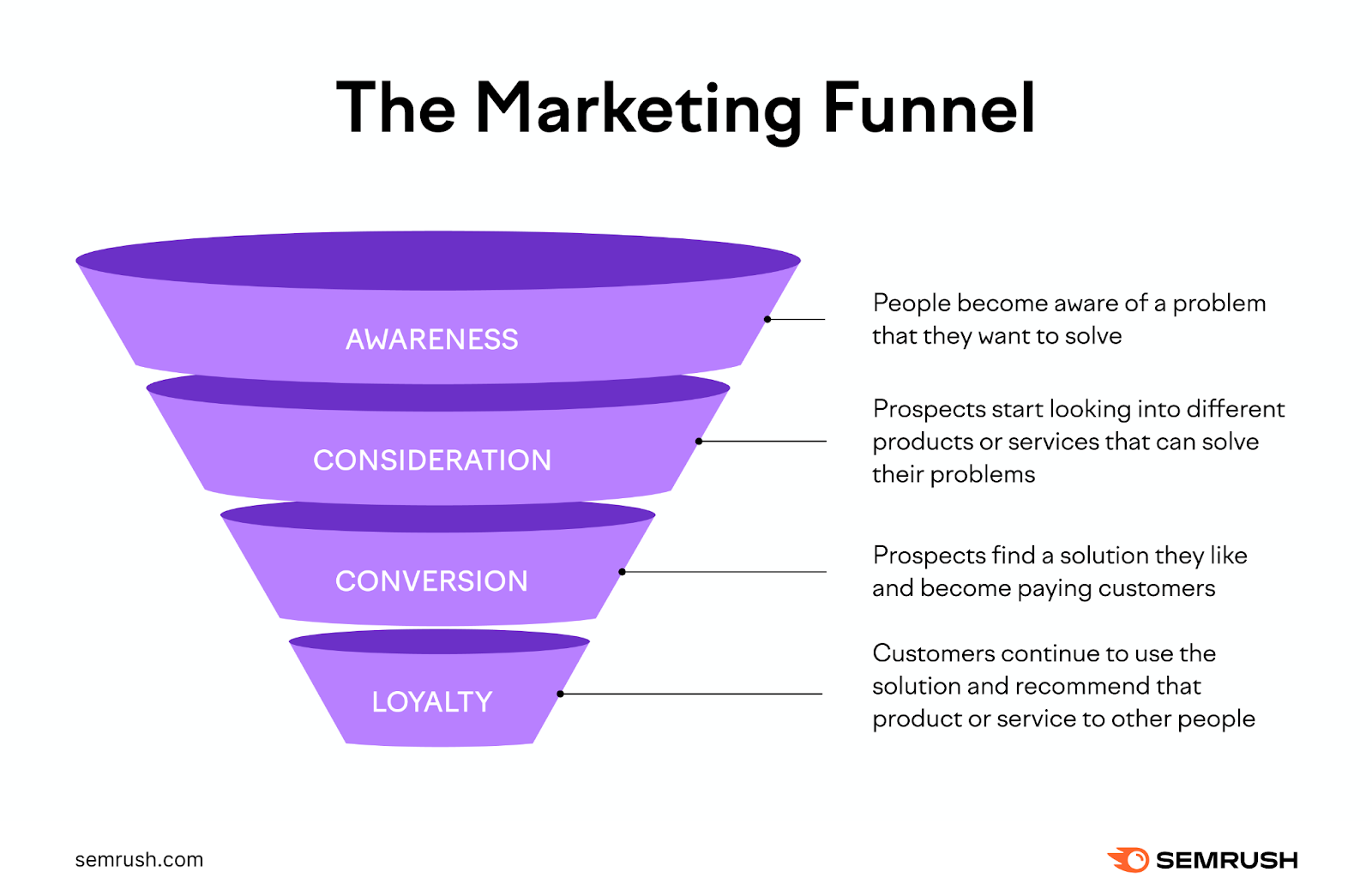Every marketer should know what the marketing funnel is. And how it can help you generate more sales.
In this article, you’ll learn about every stage of the marketing funnel. From top to bottom. Plus, get actionable tips on making it work more efficiently.
a-marketing-funnel">What Is a Marketing Funnel?
A marketing funnel is a model of the customer journey. It represents the buying stages people go through after becoming aware of a business, service, or product.
More specifically, the model shows how potential customers go from discovering a brand or product to making purchases and becoming loyal customers and advocates.
While customer journeys are varied and complex, the marketing funnel gives you a simplified framework to base your marketing strategy on.
And also helps you:
- Understand your audience and tailor your approach accordingly
- Identify and address weaknesses in your customers’ journeys
- Contextualize your marketing results
While you want to minimize the loss of potential customers, it’s natural for some people to exit at each stage.
Your highest-quality leads will make it to the end.
Why Are Marketing Funnels Important?
Using a marketing funnel can help you create more effective marketing strategies. And understand where your leads are in their buying journey.
That way, you can deliver the right message at the right time.
And figure out where leads usually drop off.
Suppose the majority of your leads disappear after the consideration stage (i.e., when leads become aware of your product as a potential solution). In that case, you might want to change your messaging.
To better illustrate the benefits of your product compared to your competitors.
Find out where your leads drop off in the funnel or why they decide to become customers.
Then, use that data to adjust your marketing strategy to meet your potential customers’ needs better.
3 Types of Marketing Funnels & Their Stages
The exact marketing funnel stages can differ by industry and target audience. Because businesses create funnels to suit the needs of their particular customer group.
1. Basic Marketing Funnel
At its base, a marketing funnel has three stages:
- Top of the funnel (ToFu): People become aware of the problem you can solve
- Middle of the funnel (MoFu): Prospects want a solution and consider their options
- Bottom of the funnel (BoFu): Prospects decide on a solution and become customers
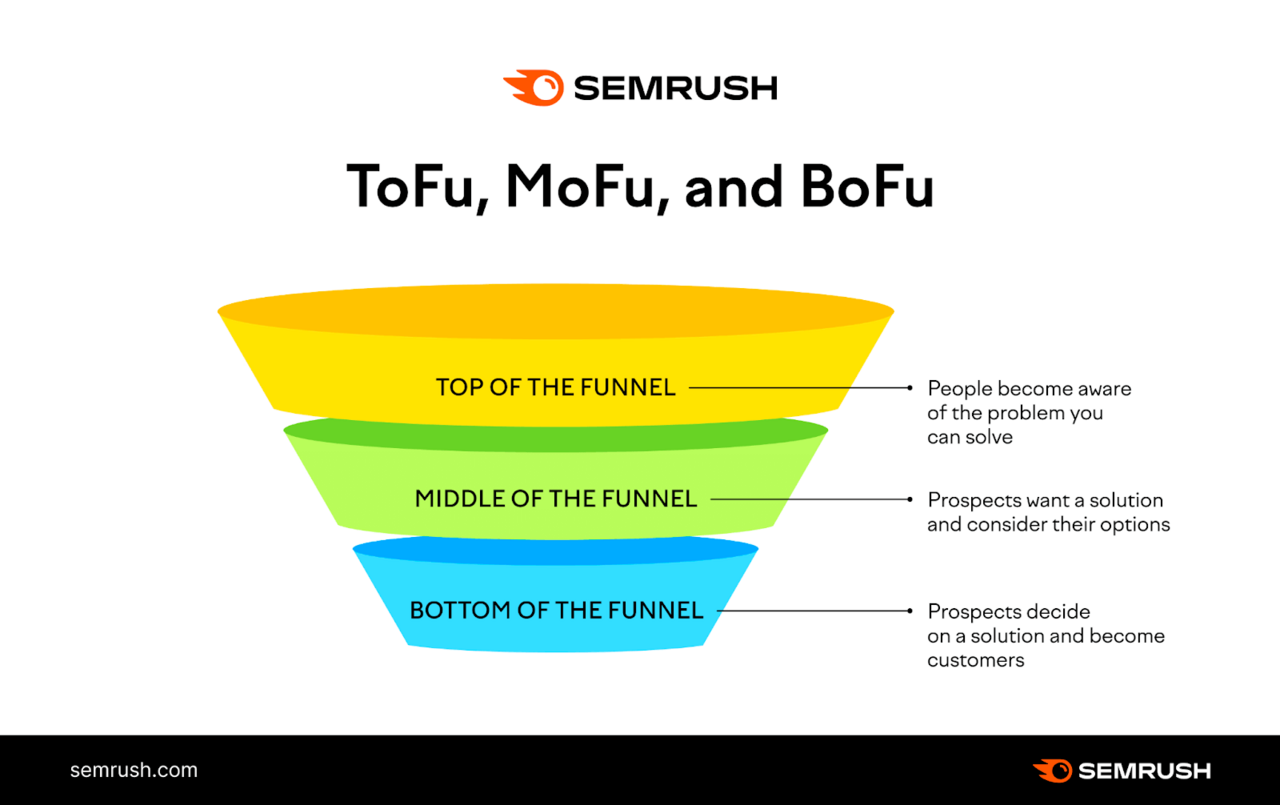
Here’s an example of the marketing funnel in action:
Imagine you’re selling band merchandise at a concert. There are three general types of people there:
- New fans (ToFu): People who got dragged along by their friends. They’re checking out the scene and could potentially become fans. In marketing terms, they’re just discovering your brand.
- Casual fans (MoFu): They’re singing along to the hits and getting into the groove. They’re starting to become engaged fans and considering checking out the merchandise.
- Die-hard fans (BoFu): They’re the ones jumping up front, holding signs, and singing every word. In marketing terms, they’re ready to buy tickets and merchandise.
2. AIDA Marketing Funnel
One of the most commonly used models is AIDA: Awareness, Interest, Desire, and Action.
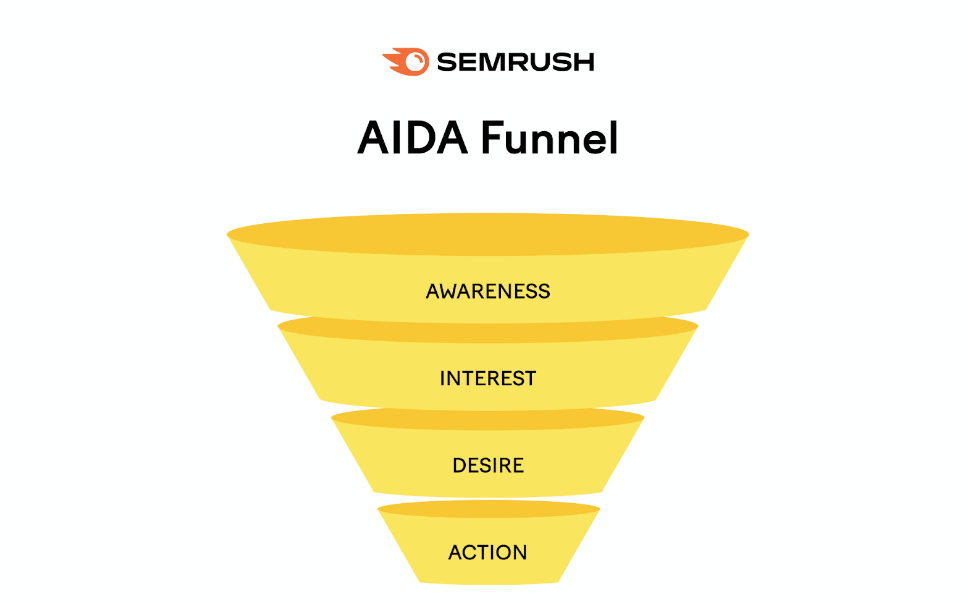
Here’s what that means:
- Awareness: A potential customer becomes aware of your brand or offering. The goal is to capture their attention and make a good first impression.
- Interest: The potential customer becomes interested in your offering. The goal is to maintain their curiosity and tell them more about your product or service.
- Desire: Here, customers develop a preference for your brand and consider purchasing. The goal is to foster a deep emotional connection and convince them of your product’s value.
- Action: This is when customers make a purchase or take a desired action. Your goal should be to make it easier for them to choose your offering by simplifying the decision-making process.
3. Granular Marketing Funnel
You can go even more granular than the AIDA model and break down the marketing journey into more specific stages.
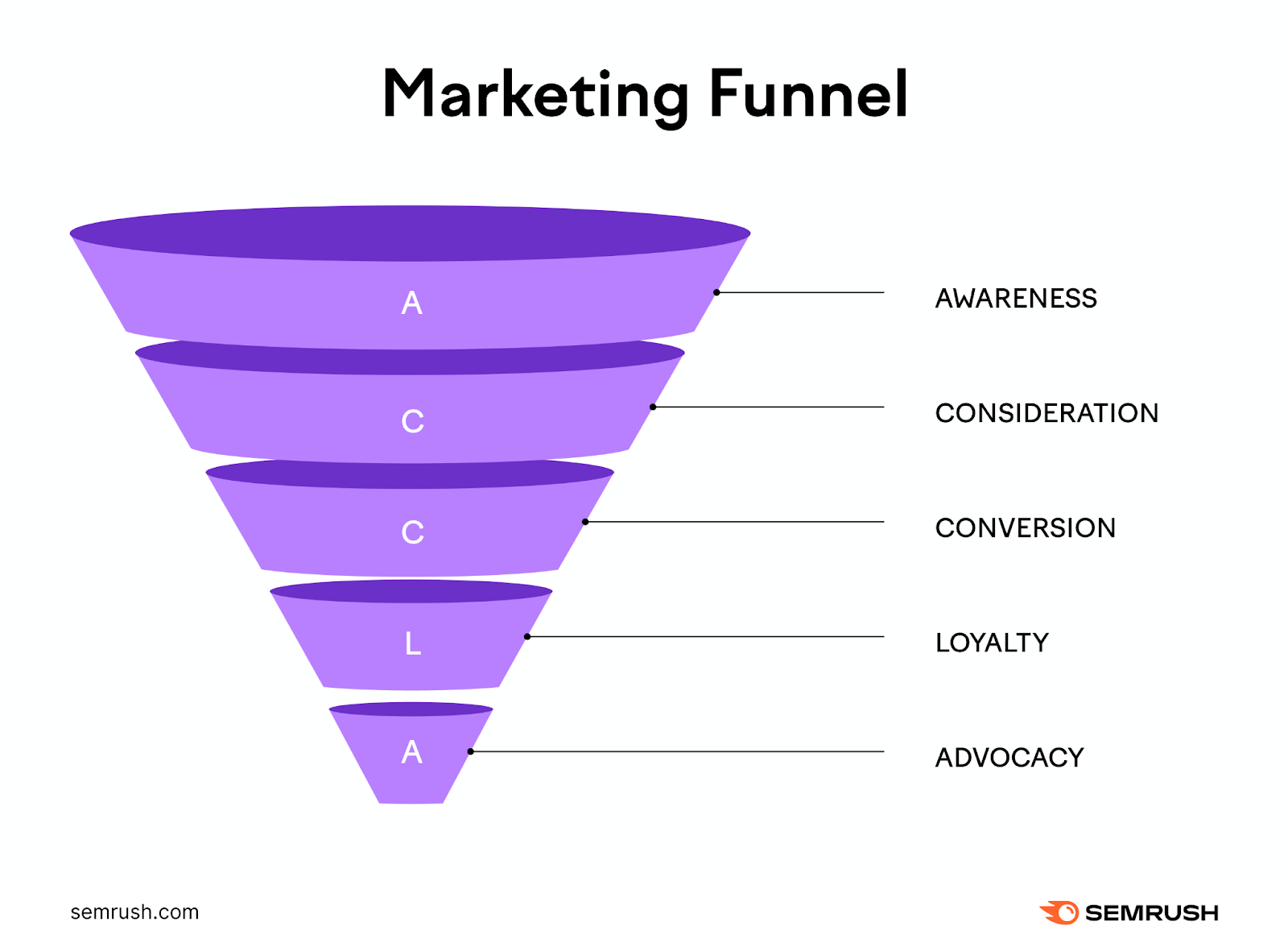
Here’s what each stage means:
- Awareness: A potential customer becomes aware of your brand or offering. The goal is to capture their attention and make a good first impression.
- Consideration: Customers are evaluating your products or services and comparing them with alternatives. The goal is to give them information that encourages them to choose your brand.
- Conversion: Customers decide to make a purchase. The goal is to facilitate a smooth and compelling buying process that leads to a transaction.
- Loyalty: Customers continue to purchase from your brand regularly. The goal is to build a strong relationship that encourages repeat business.
- Advocacy: Customers are so satisfied that they actively promote your brand to others. The goal is to turn loyal customers into enthusiastic brand ambassadors.
Further reading: ToFu, MoFu, BoFu: A Practical Guide to the Conversion Funnel
Strategies for Each Stage of the Marketing Funnel
Customers at different stages of the marketing funnel respond well to different messages.
Here are strategies you can use to reach potential customers. Based on where they are in their purchasing journey.
Top of the Funnel (ToFu)
Potential customers in the top of the funnel (ToFu) stage have just become aware of a problem. And are starting to look for the right solutions.
Which means it’s time to introduce your business, service, or product as the solution they are looking for.
To properly address leads at the ToFu stage, define your target customers and increase brand awareness.
Here’s how.
Define Your Target Customers
Your target customers are people who are most likely to become paying customers. After all, not everyone who sees your brand is going to buy what you offer.
Start by analyzing your existing customers. What kinds of people have already purchased your product or service?
Find out using Google Analytics’s “User attributes overview” report.
Take note of your existing customers’ age ranges, genders, countries, cities, languages, and interests.
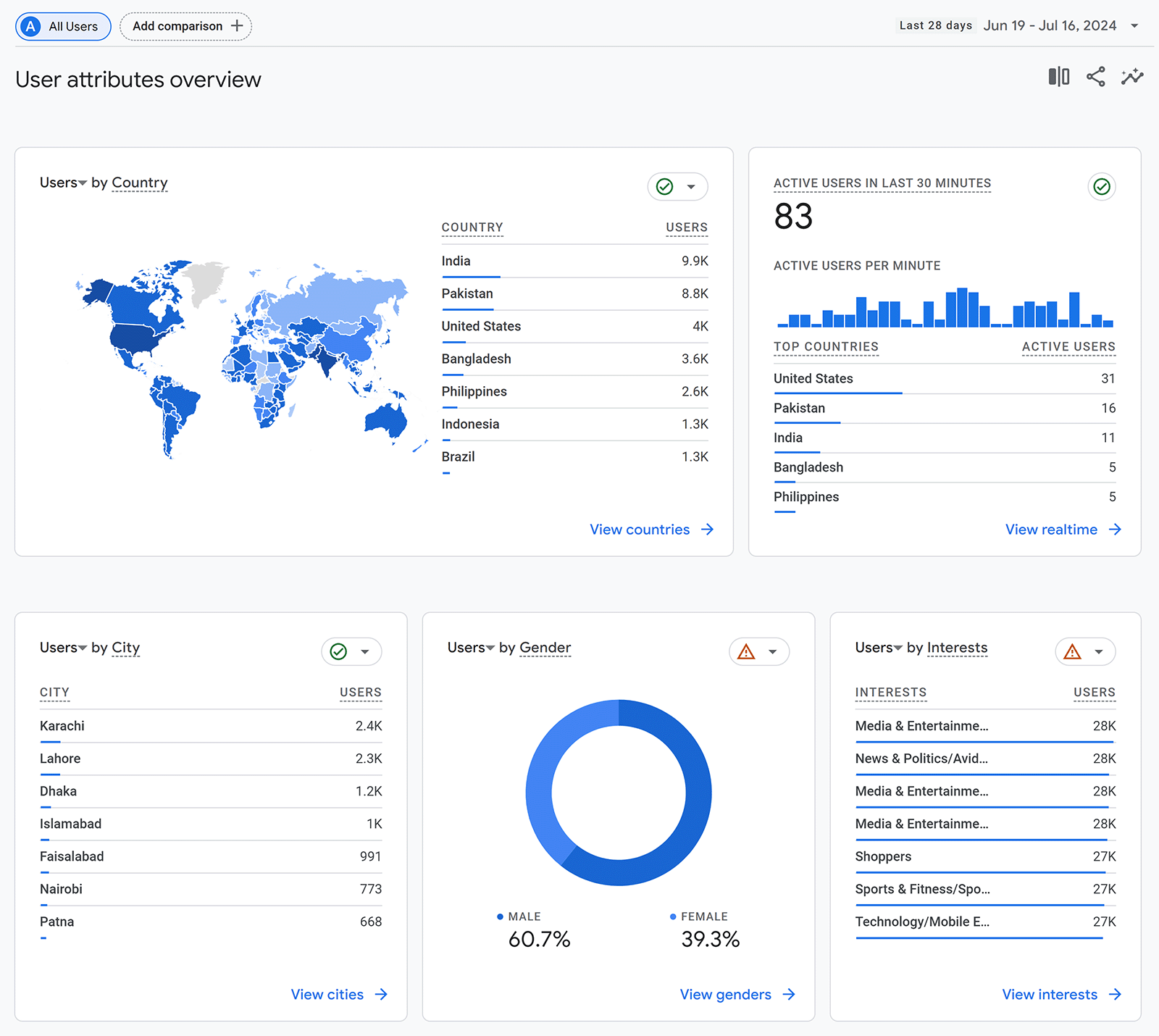
And see which audiences are most likely to engage and convert by comparing segments in the “Demographic details” report:
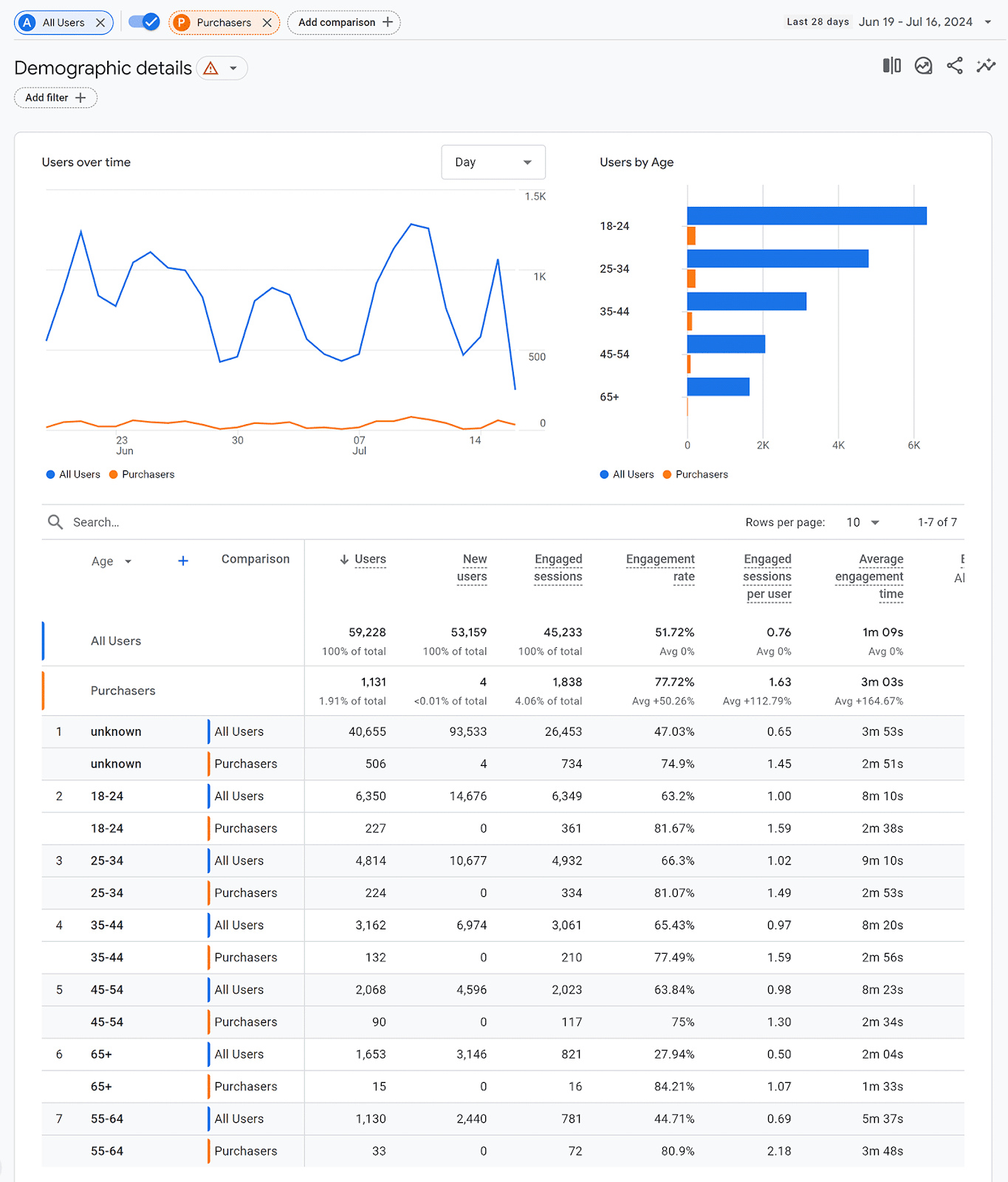
In this example, 25- to 35-year-olds are the most likely to visit the website and make a purchase.
After that, perform market and competitor research with Semrush’s One2Target tool. To get the following data about your potential audience:
- Age
- Sex
- Household size
- Income level
- Employment status
- Education level
- Social media usage
- Interests
- Device usage
You can also use the tool to analyze up to five competitors simultaneously.
First, enter your competitors’ domains into the tool. And click “Analyze.”
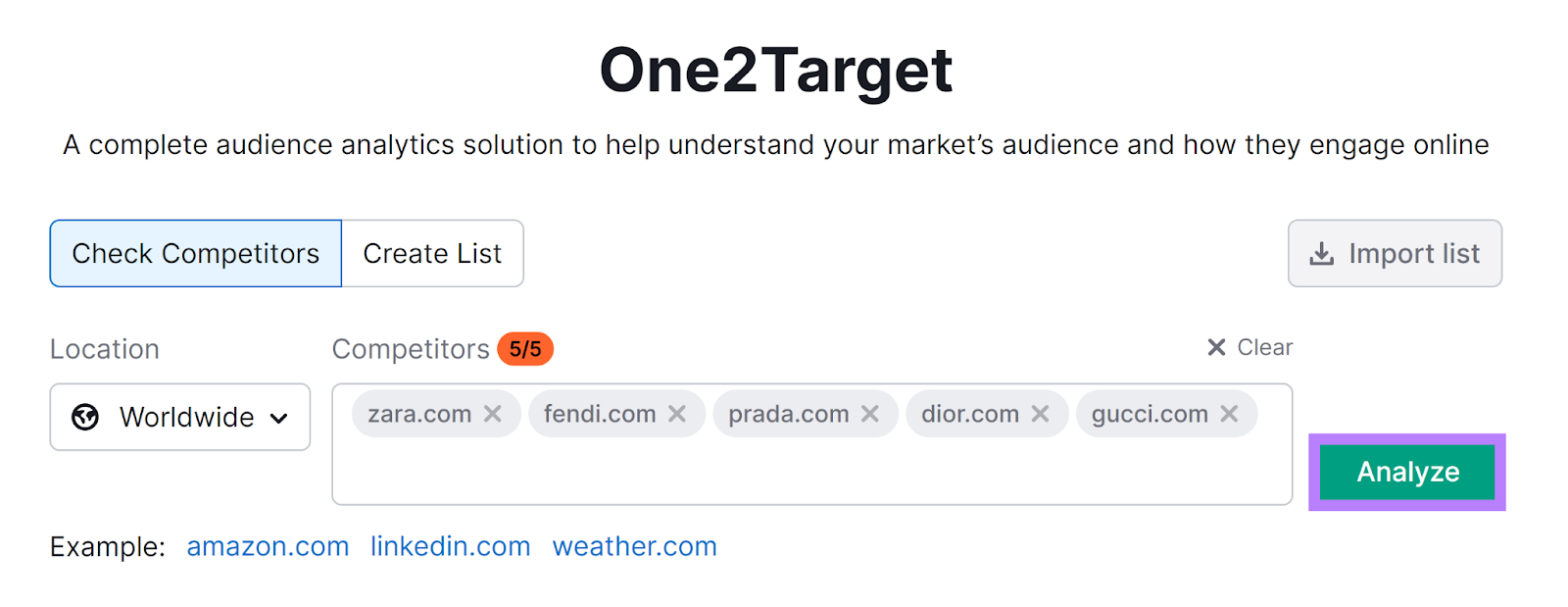
The tool will generate a report of your competitors’ audience. In this example, you can see that Gucci is most popular among 35- to 44-year-olds.
Whereas Zara, Fendi, Prada, and Dior skew toward a slightly younger audience.
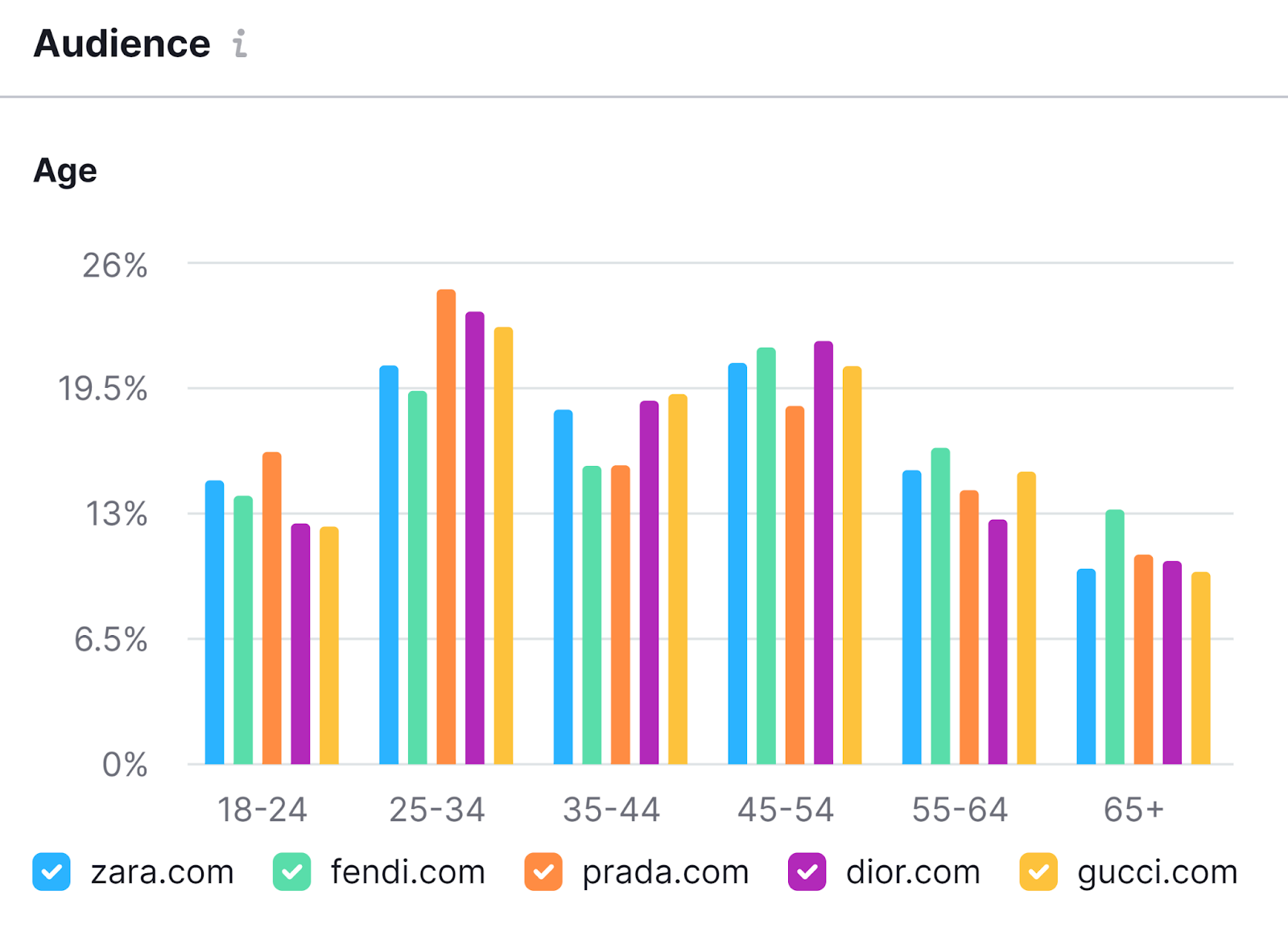
Use the information to create buyer personas—i.e. profiles that describe your quintessential customers. So you can craft marketing messages that speak directly to your audience.
Increase Brand Awareness with Inbound Marketing
Inbound marketing is a tactic that attracts your target market’s attention. By creating content that is relevant to them.
In other words, use relevant keywords to rank on Google (or other search engines). So your target audience finds your brand even if you don’t reach out.
This tactic is often better than advertising because it feels less promotional. And can deliver better return on investment at this stage.
Here’s an example.
Mattress brand Casper has a blog post about cleaning blood out of sheets. That includes a step-by-step cleaning guide and some cleaning tips—not a hard sales pitch.
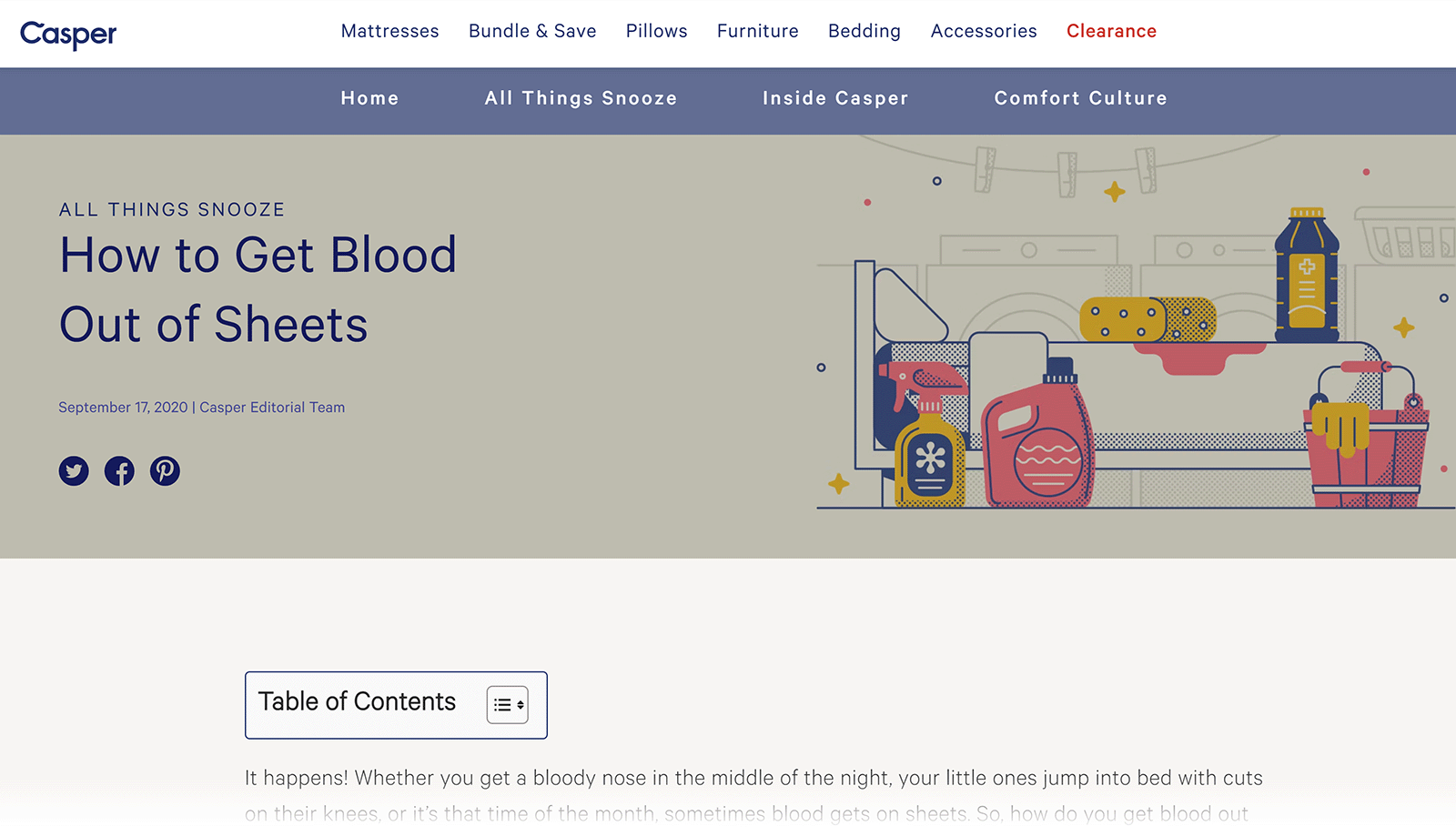
The goal of this article isn’t to sell a product. It’s to increase brand awareness by:
- Discussing a broad but relevant topic that potential customers are interested in
- Ranking on Google so potential customers can easily find the brand
And this tactic works. In fact, the cleaning article from Casper gets around 10.2K visitors per month, according to Semrush’s Organic Research tool.
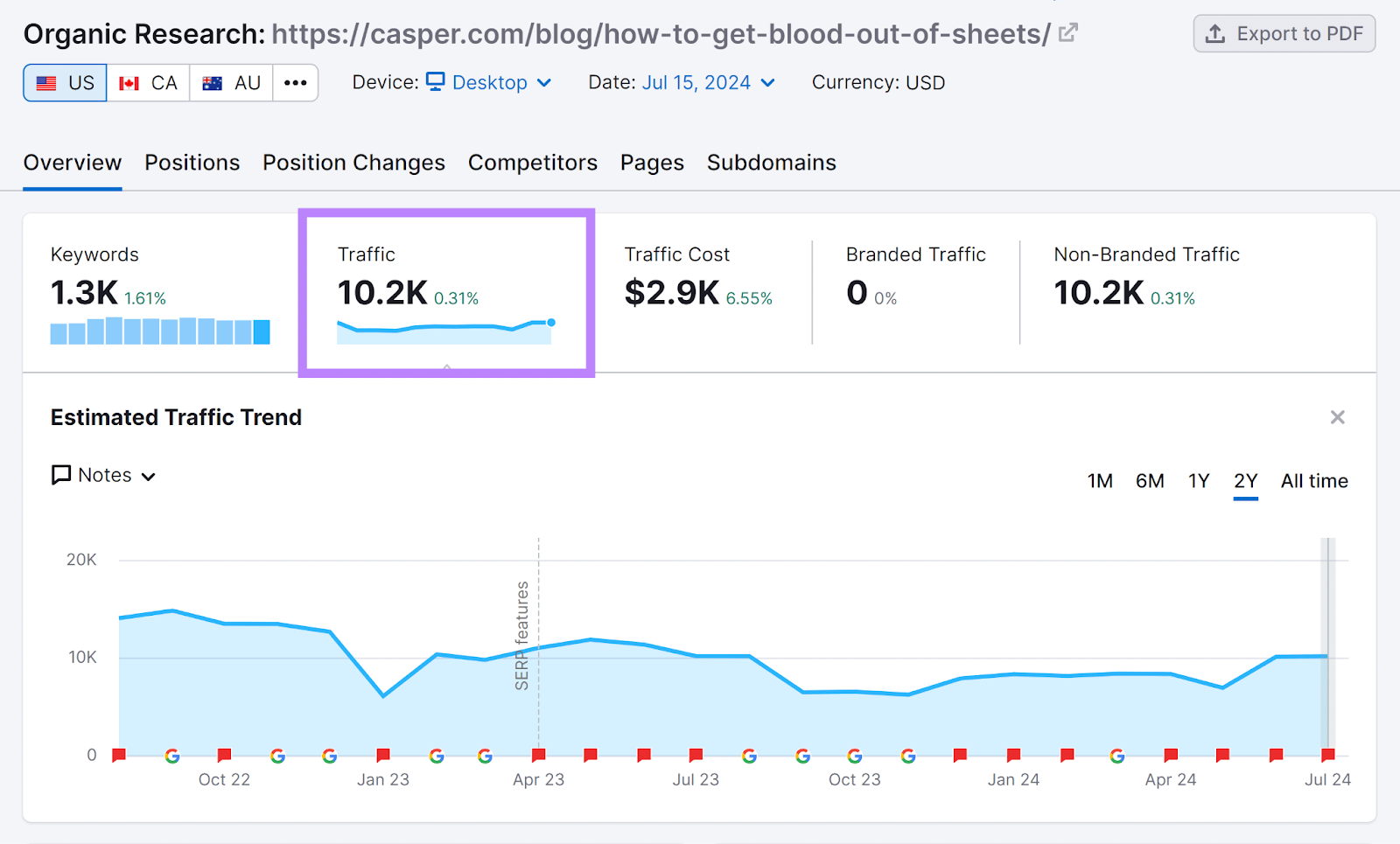
Start your inbound marketing strategy by finding keywords your prospects are searching for. Try using Semrush’s Keyword Magic Tool.
Then, target those keywords with valuable content that naturally draws potential customers to your business.
Open the tool. Enter a keyword to base your search around. This should be a topic related to your product or service.
Enter your domain name into the tool to get AI-powered, personalized keyword data. Then, click “Search.”
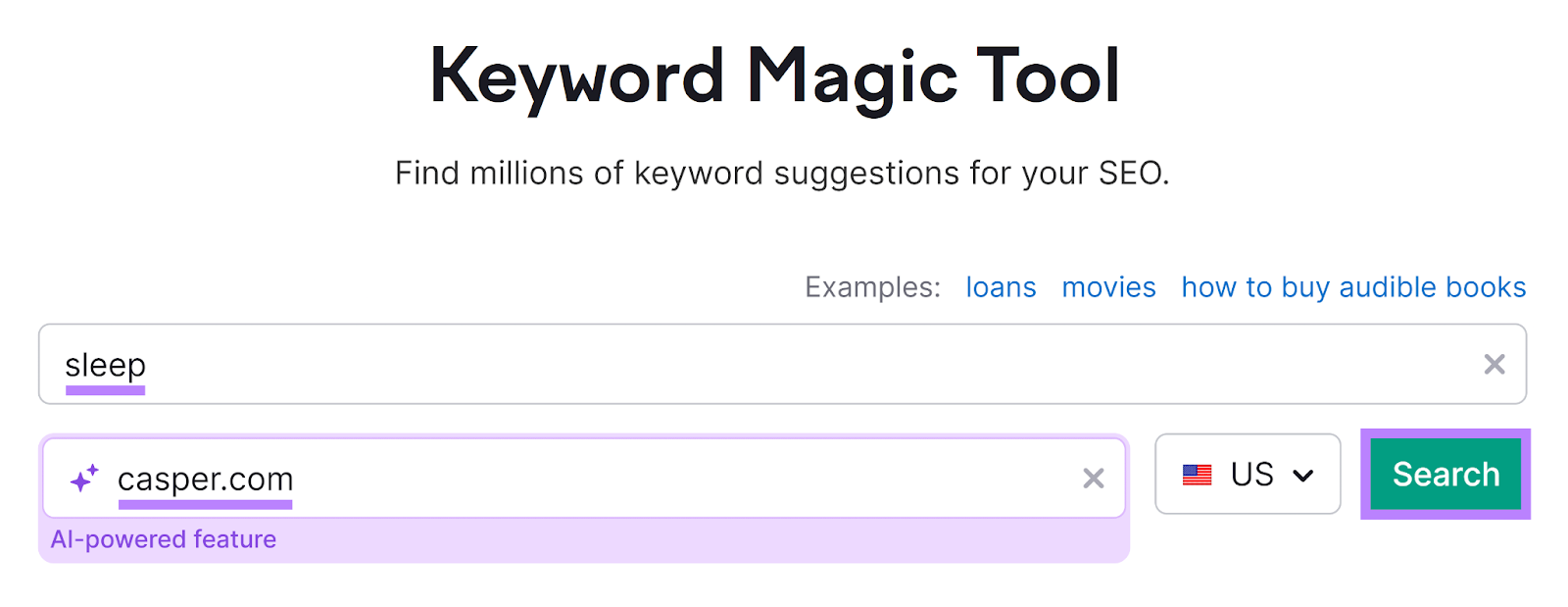
At the ToFU stage, people are usually looking for general information. So they use keywords with informational intent.
To find those keywords, click on the “Intent” filter. And select the check box beside “Informational.” Then, click “Apply.”
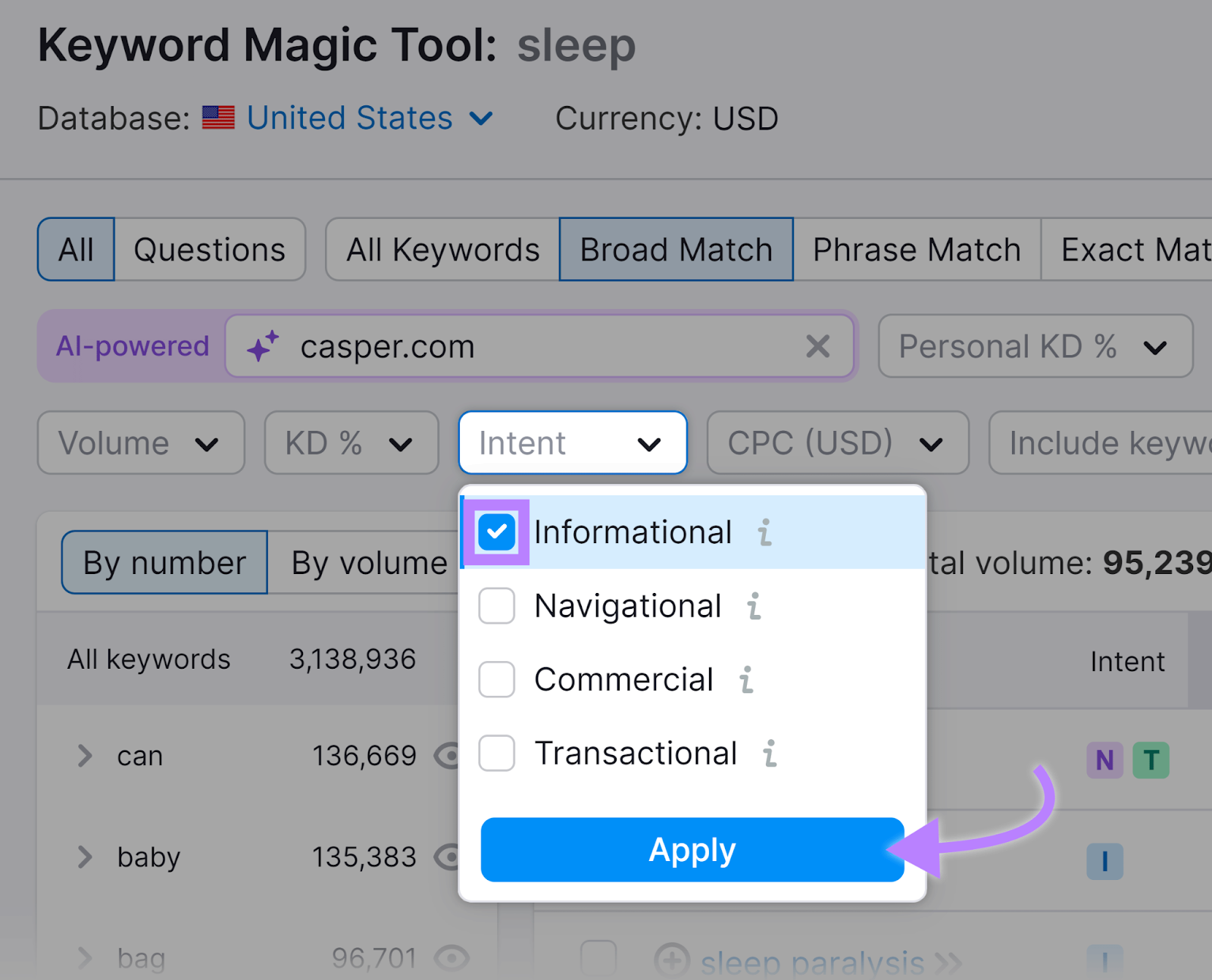
Now you have a list of informational keywords. Look through the keywords and take note of the following columns:
- Volume: How many searches a keyword gets per month. We recommend taking note of keywords with volumes higher than 100.
- PKD%: How easy or difficult it is for your specific website to rank for a keyword, as calculated by AI. We recommend noting keywords with PKD% scores lower than 50%.
From the list above, Casper could write a blog post around the keyword “how to go to sleep fast” to get more people into their marketing funnel.
Now that you have your list of keywords, the next step is writing search-friendly content. Which can help you secure high search rankings and get more people into your marketing funnel.
However, search isn’t the only important channel for brand awareness. There’s also:
- Digital PR: Earn media coverage on the sites your prospects visit
- Social media marketing: Create engaging and shareable social media content
- Online communities: Answer relevant questions on sites such as Reddit and Quora
- Guest blogging: Write helpful articles on sites your audience visits
- Events: Speak at or run events that your target audience attends
- Email marketing: Keep in touch with prospects who’ve signed up to your emails
Just be careful not to spread yourself too thin. Focus on one or two tactics. Especially when you’re starting out.
The best strategy depends on your buyer personas. And the resources available to you. Testing and measuring will help you spend time and money in the most efficient way possible.
Middle of the Funnel (MoFu)
The middle of the funnel (MoFu) is where people identify a problem and research solutions. At this stage, they want to know which product or service is right for them.
For example, they know that they could benefit from a new mattress. But they don’t know what size or type they need.
Some marketers break this down into interest and consideration stages. Or something similar, like desire and evaluation.
Two tactics to reach your MoFu leads are educating them and managing your brand’s reputation.
Educate Your Prospects
Educating your prospects displays your knowledge. Which helps build trust and credibility with them. And can establish you as an expert in your niche.
This type of content can also highlight what differentiates you from your competitors. And guide potential customers toward a buying decision.
You can do that with a great support team. Who are always available to answer questions through live chat, phone, email, or social media.
In addition to a support team, create self-serve resources that prospects can refer to. And content that displays the usability and special features of your product or service.
Like success stories and product overviews. That your audience may find useful.
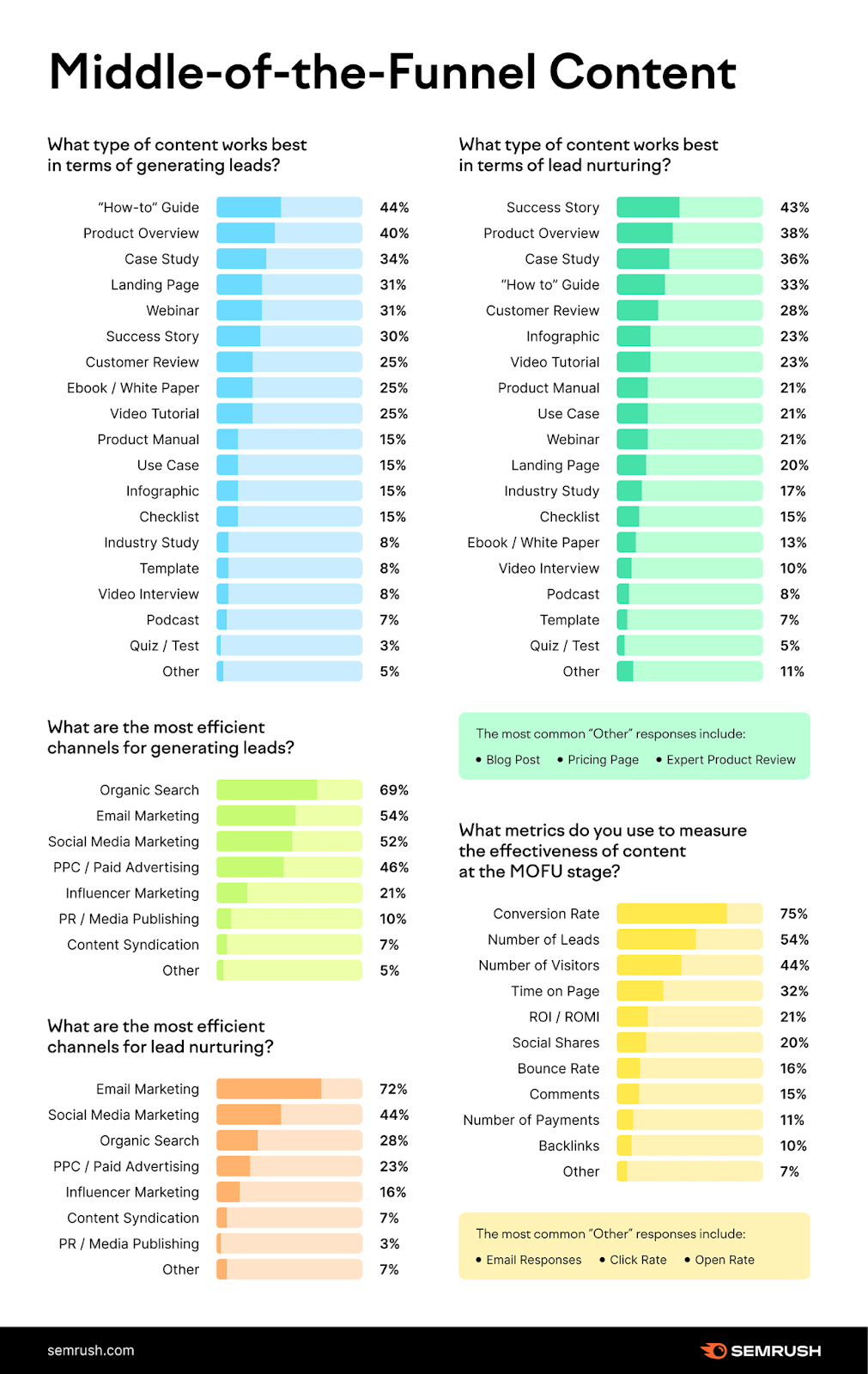
For example, Casper has a mattress size comparison guide that tells visitors more about their products. And attracts potential customers who are looking for the perfect, new mattress.
This article gets more than 472,000 unpaid visits per month from Google.
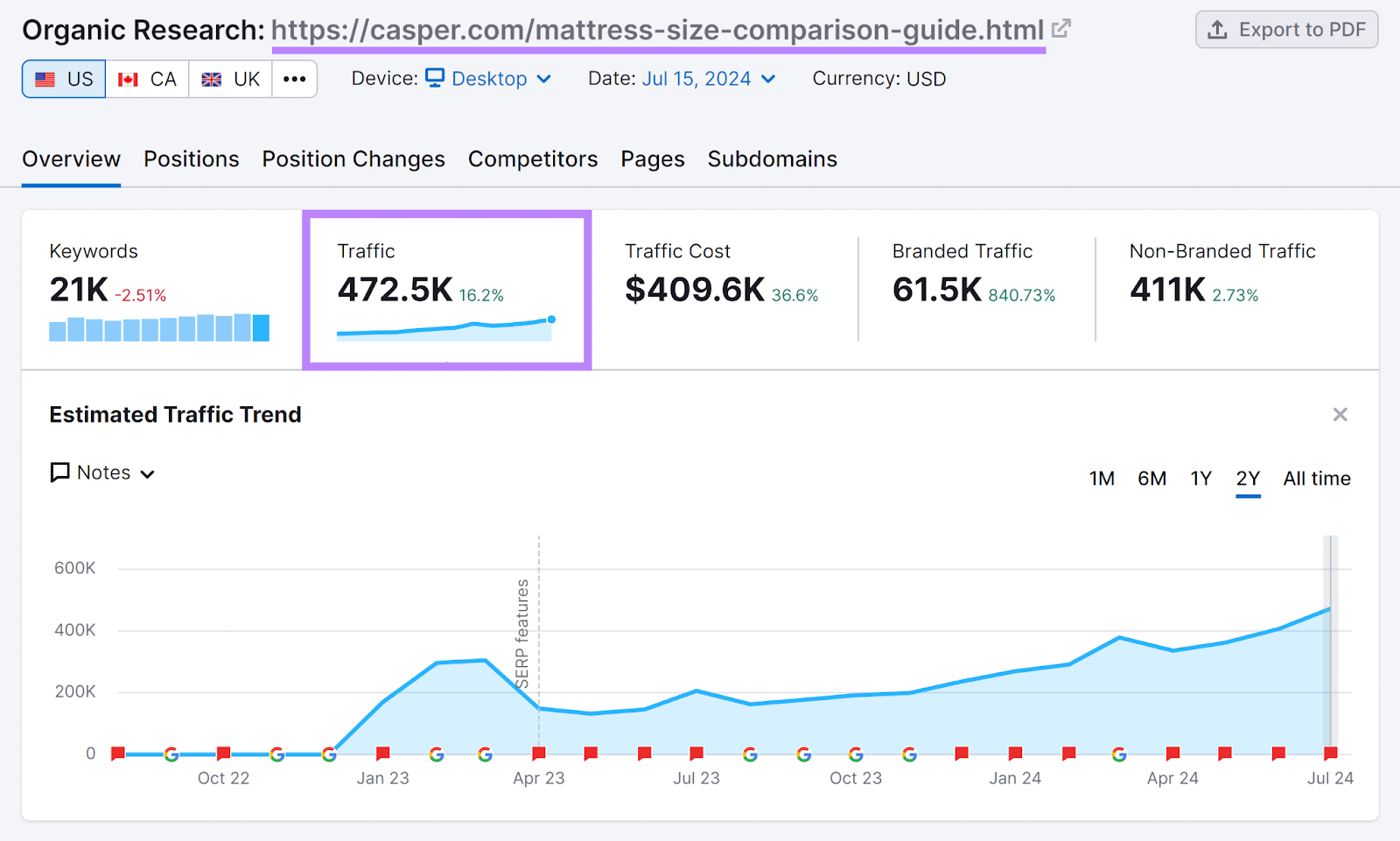
Start creating MoFU content with Semrush’s Keyword Magic Tool. Use it to identify your audience’s main questions and concerns.
Enter a seed keyword related to your brand, enter your domain URL, and click “Search.”
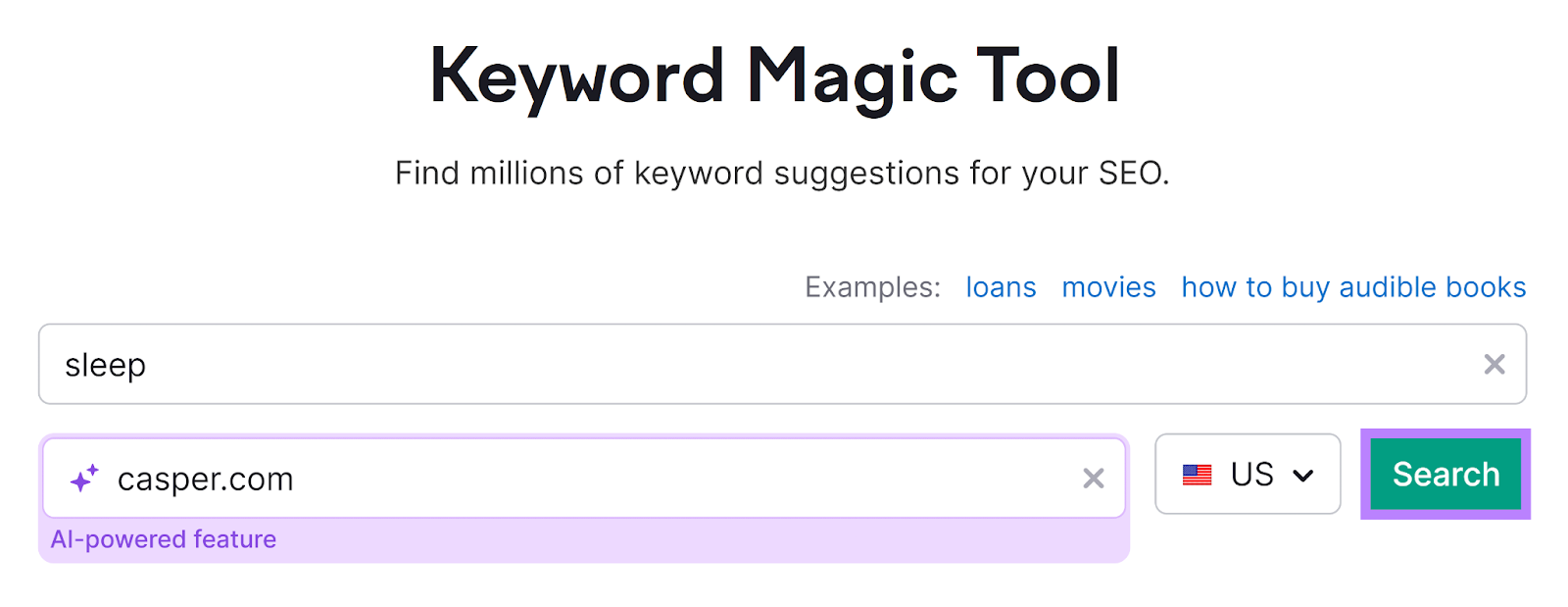
Use the “Intent” filter like before. And click on the box beside “Commercial.”
People who use keywords with commercial intent are usually looking into various products or services that may solve their problem.
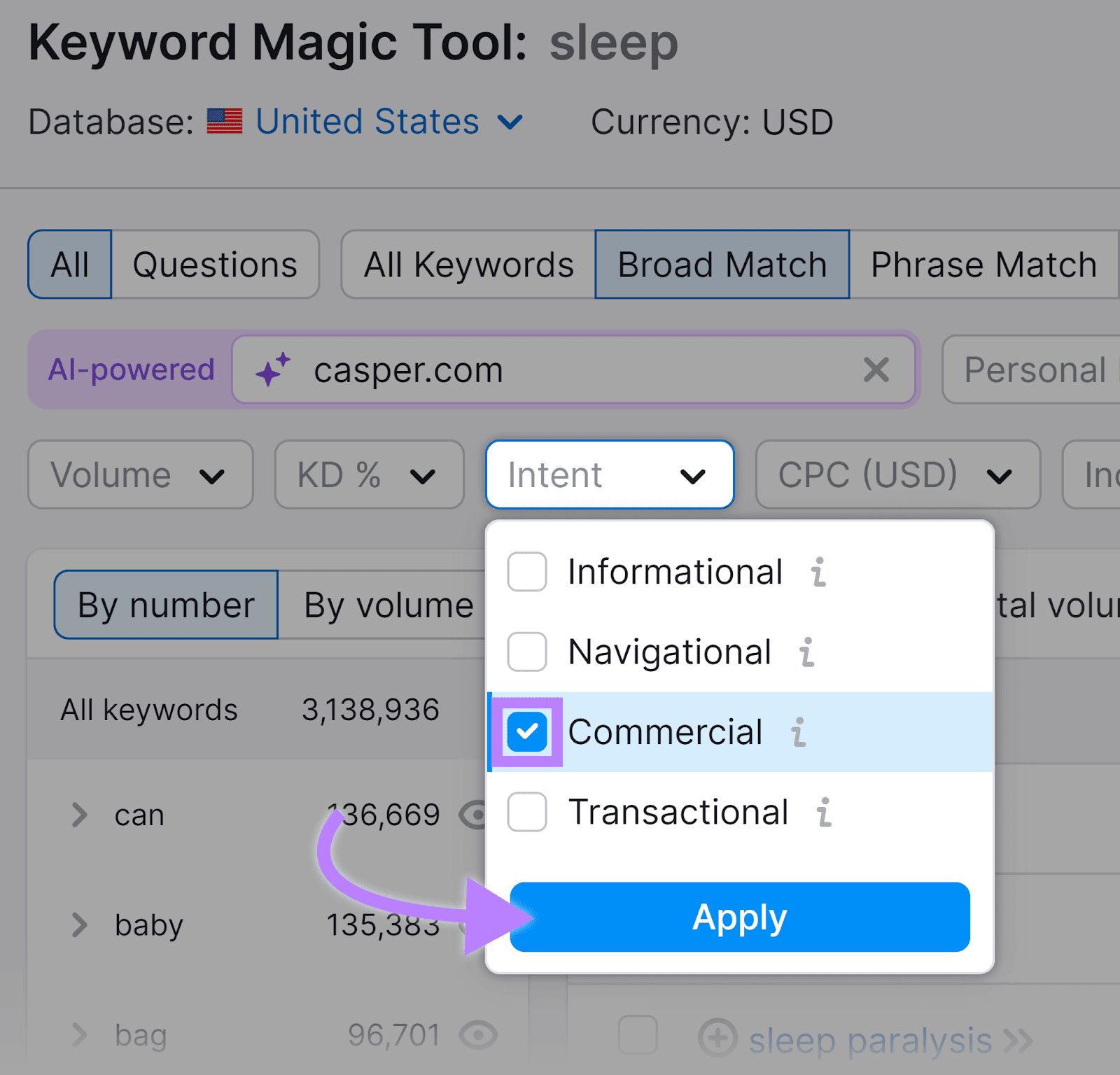
Look through the list. And choose keywords relevant to your brand. And to your audience members who are considering buying your product (or your competitors’ products).
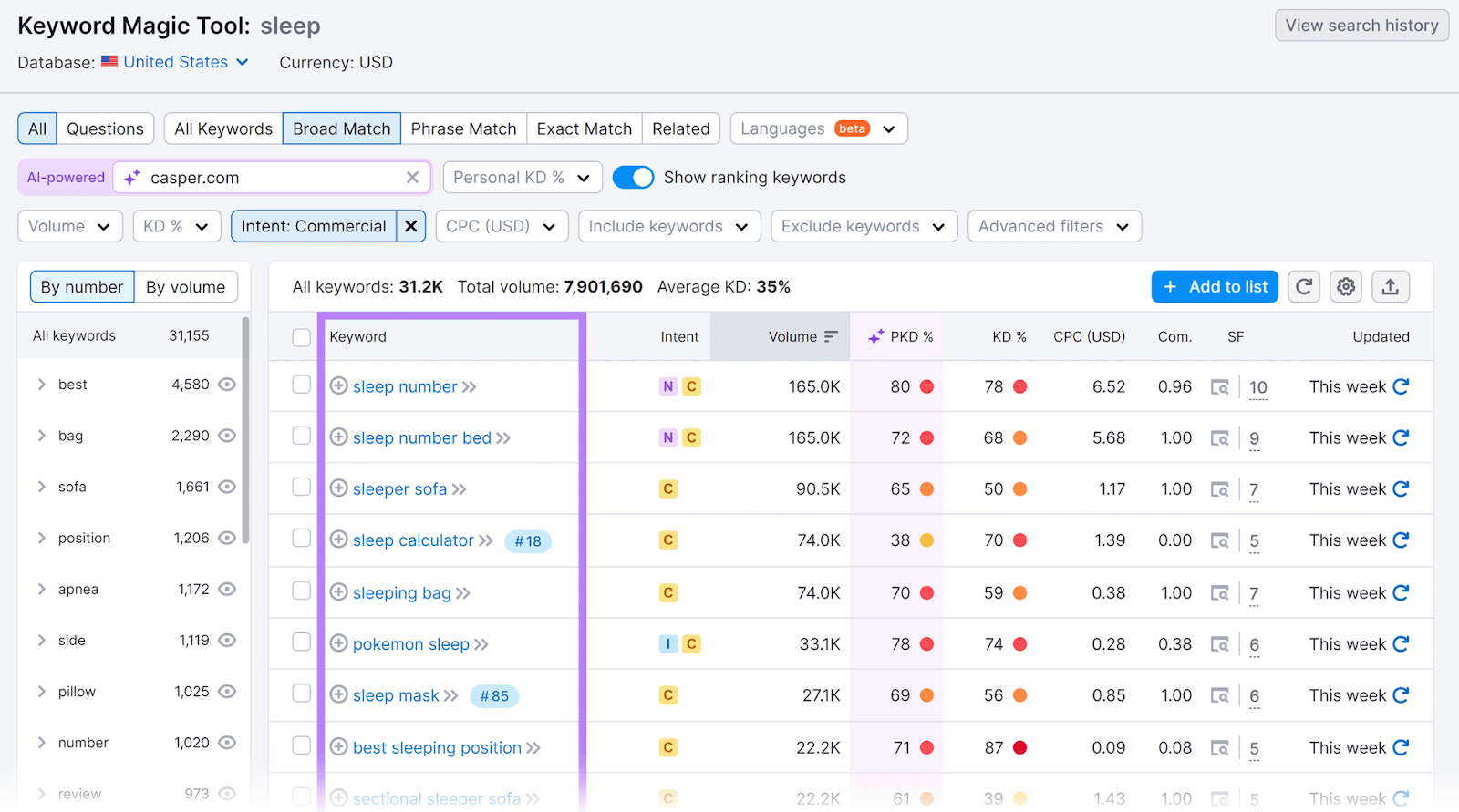
Manage Your Reputation Online
Online reputation management means getting more positive reviews and media coverage. And addressing negative feedback.
So you can build more trust with potential customers. And secure more sales.
After all, prospects ask around and look at reviews when they’re looking into a product to buy.
If you have a lot of unaddressed negative Google reviews, they’ll probably think twice before buying your product or service.
To learn about your reputation, search for your brand name on Google.
Look at the reviews and third-party results that come up. Are they positive?
Next, search for commercial keywords like “best [product]” or “[service] reviews.”
- Is your brand mentioned in the top-ranking pages?
- If so, is it being referenced positively?
- If not, what can you do to fix it?
For example, if you search “best mattress brands,” you’ll see reviews and recommendations right away.
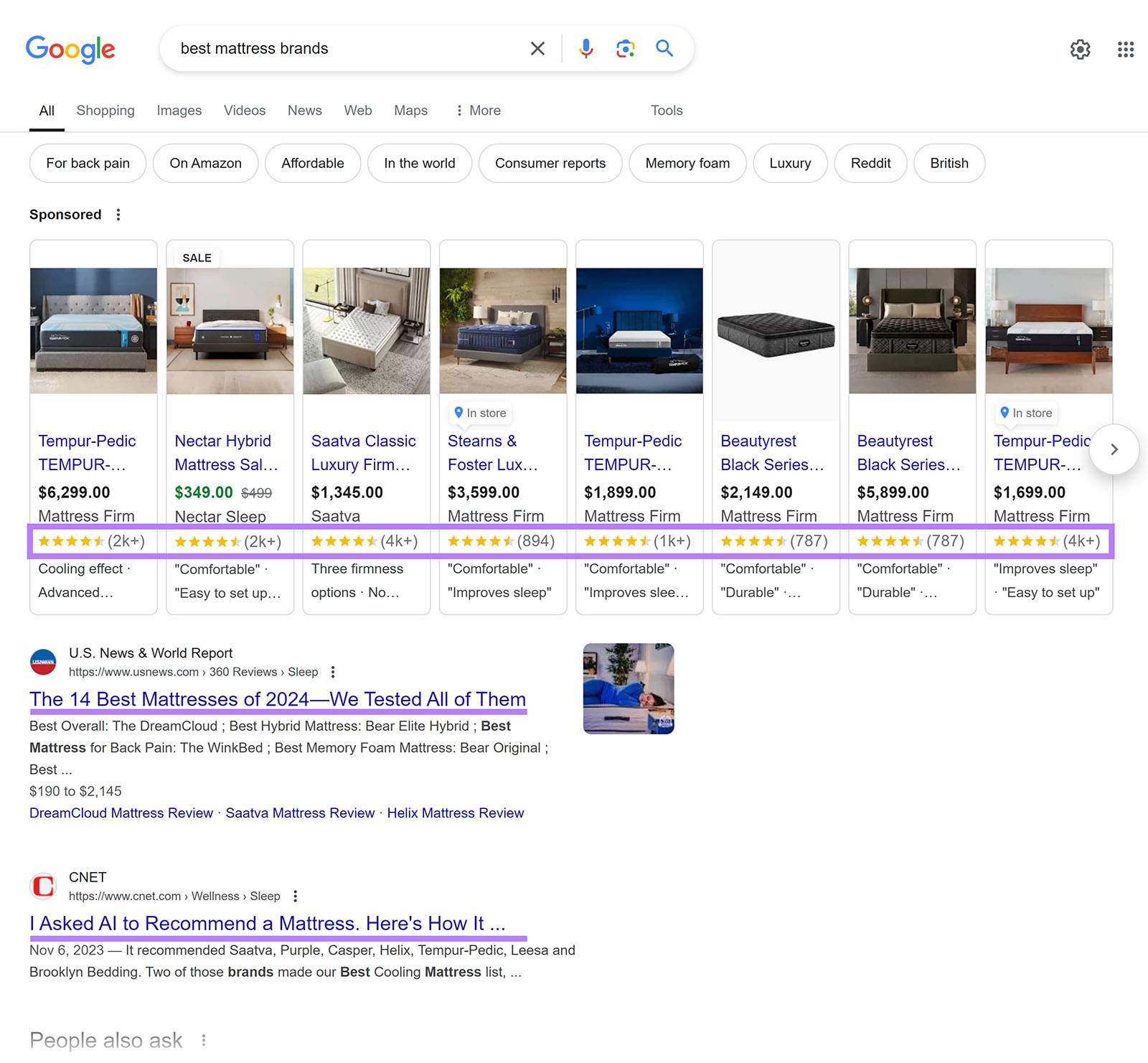
Also use Semrush’s Media Monitoring to track brand mentions across the web. And quickly check whether those mentions have positive or negative sentiments.
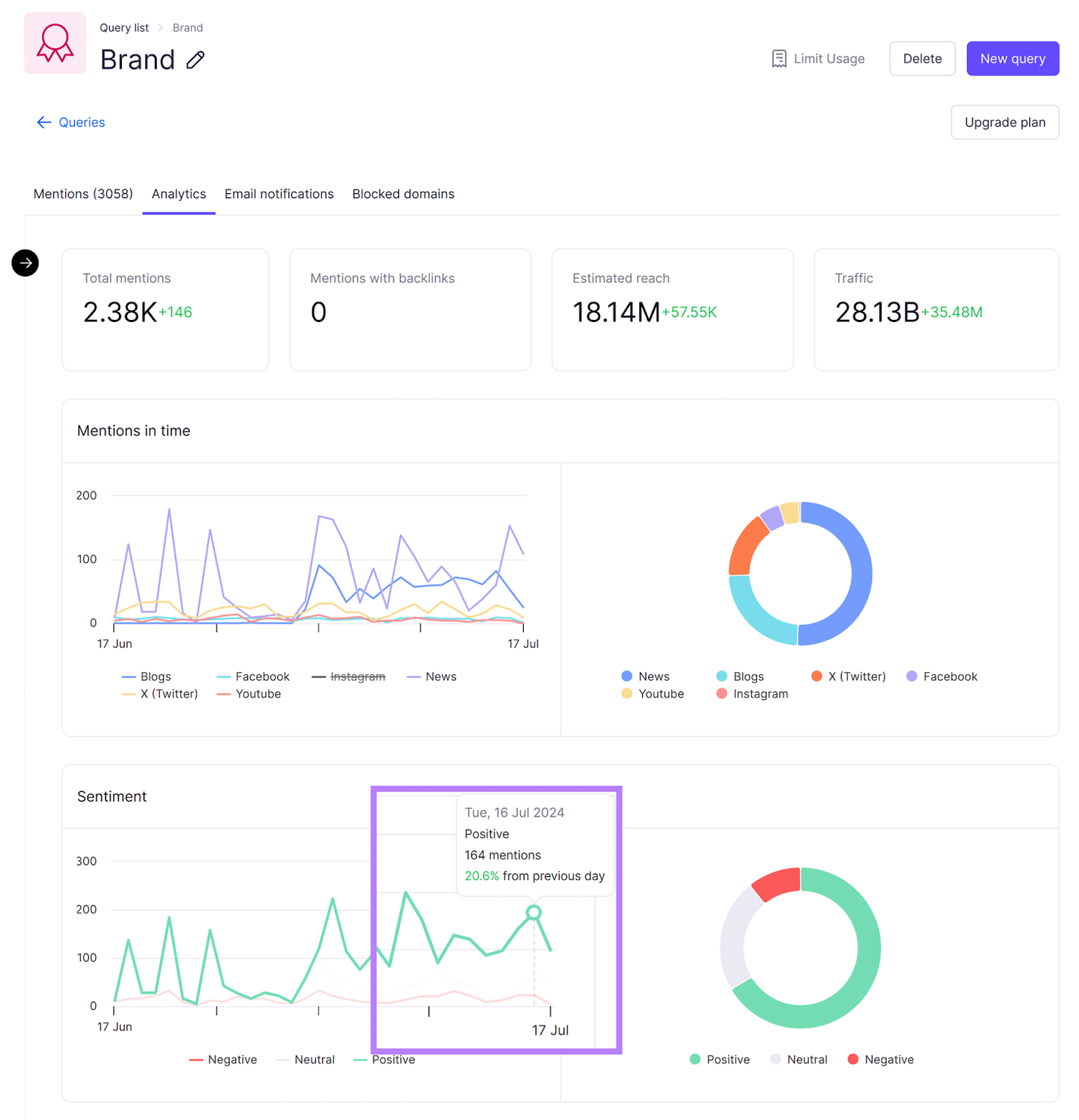
If your brand is a local business, you can use Semrush’s Listing Management tool to get your business listed in top directories, monitor and respond to reviews, and track your rankings on Google.
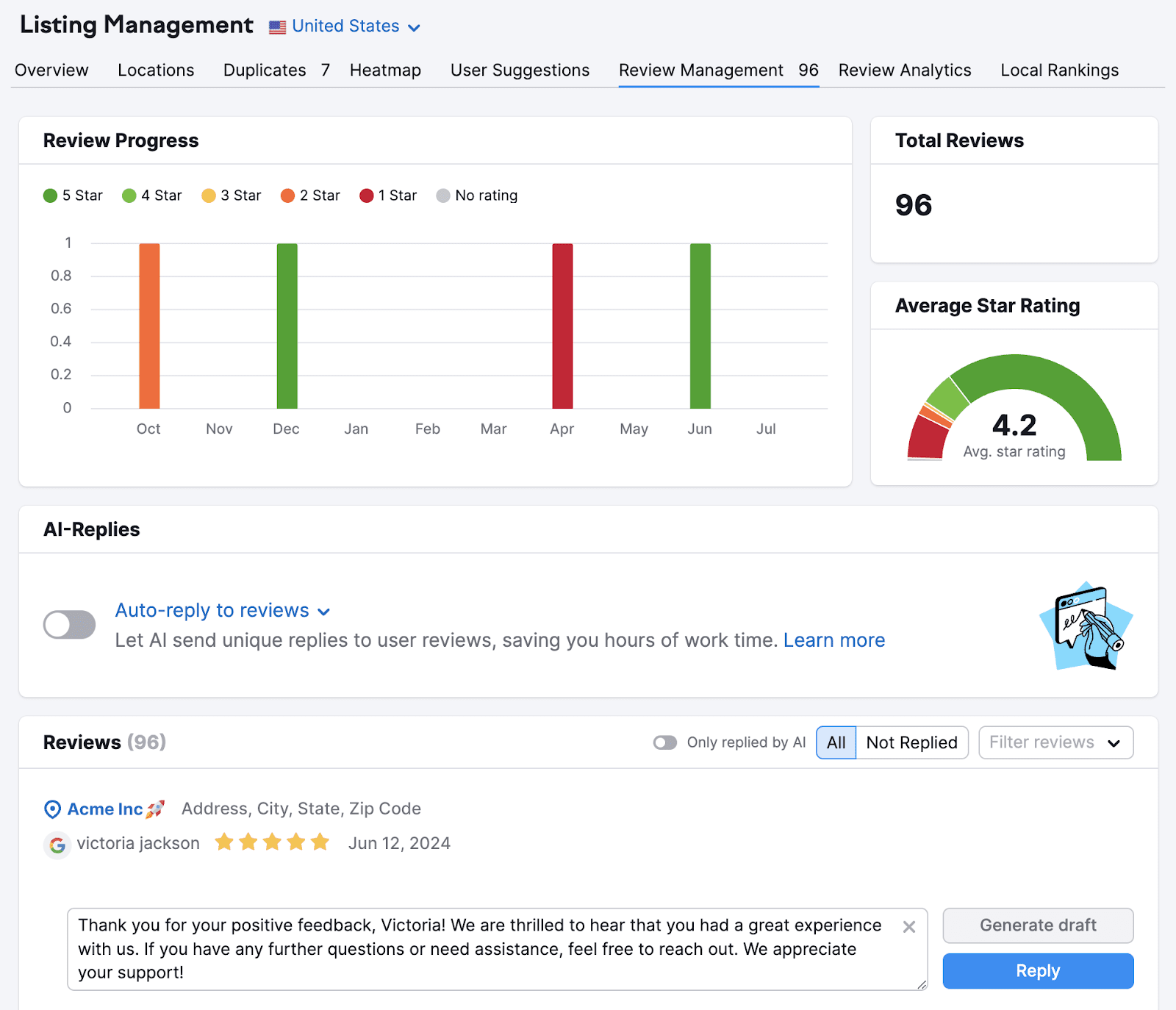
Bottom of the Funnel (BoFu)
The bottom of the funnel (BoFu) is where prospects become customers. At this point, they’ve done their research and are ready to buy.
If they haven’t yet chosen a provider, they will likely head to Google. And search for transactional keywords like:
- “Buy mattress”
- “Mattress store near me”
- “King size memory foam mattress topper”
If they have already chosen a provider, they might go straight to that provider’s website. Or search for a navigational keyword like “Casper mattress.”
Either way, you want to make sure you’re there to get their clicks.
To do that, build a great landing page. Then continue to nurture buyers and turn them into loyal brand advocates.
Here’s how.
Build Awesome Landing Pages
Landing pages are webpages built to convince (and enable) visitors to buy.
The quality of a landing page affects its organic and paid rankings.
And its bounce rate (i.e., the percentage of unengaged sessions on your site) and conversion rate (i.e., the percentage of visitors that move forward with the purchase).
Some landing page best practices include the following:
- Optimize for target keywords
- Reduce the barriers to purchase
- Reassure customers they’re making the right decision.
Here’s one of Casper’s product pages. And some of the CRO (conversion rate optimization) techniques the brand uses to maximize sales.
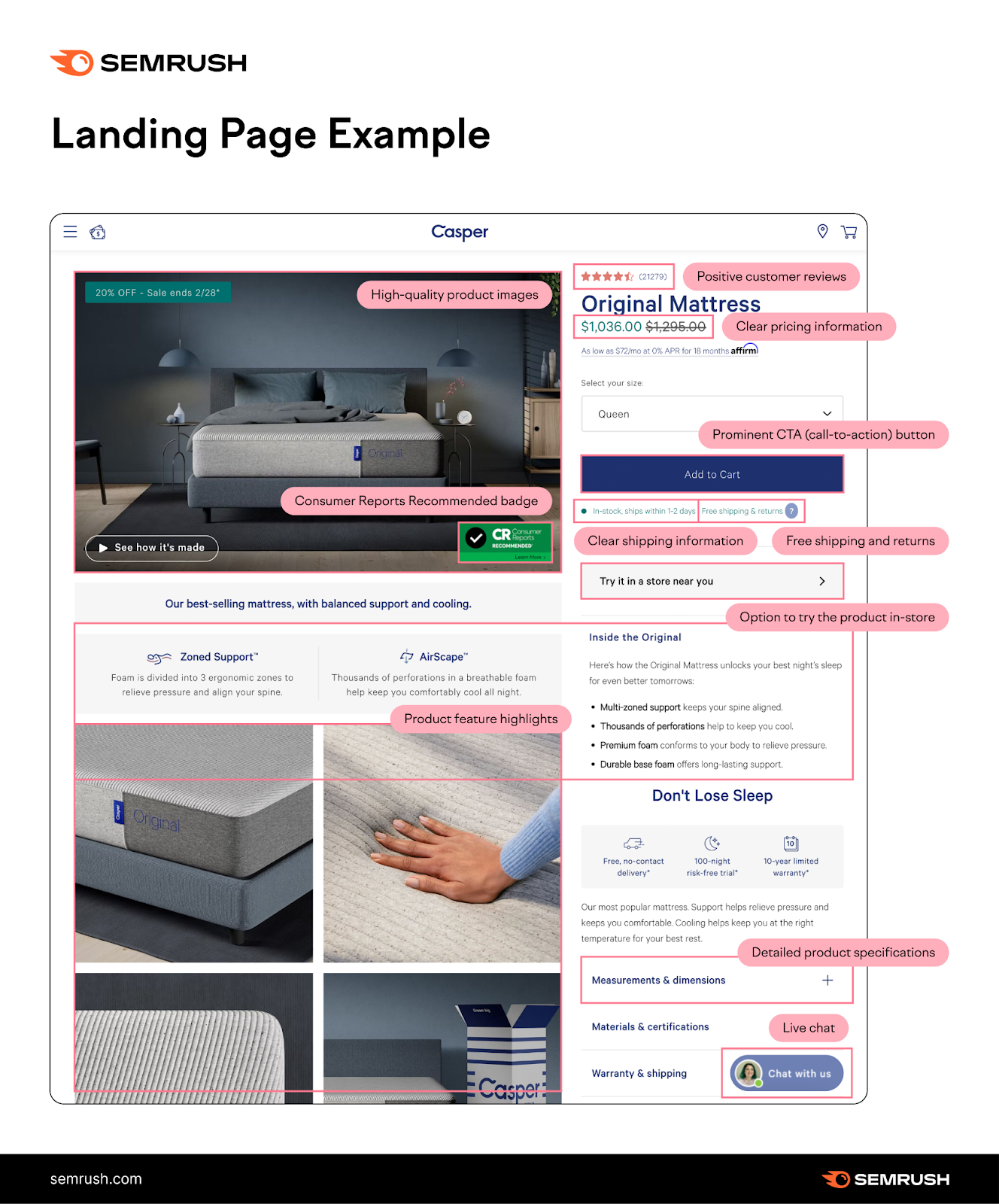
Get suggestions for your landing pages with Semrush’s On Page SEO Checker. It gives ideas on improving content, user experience, and more.
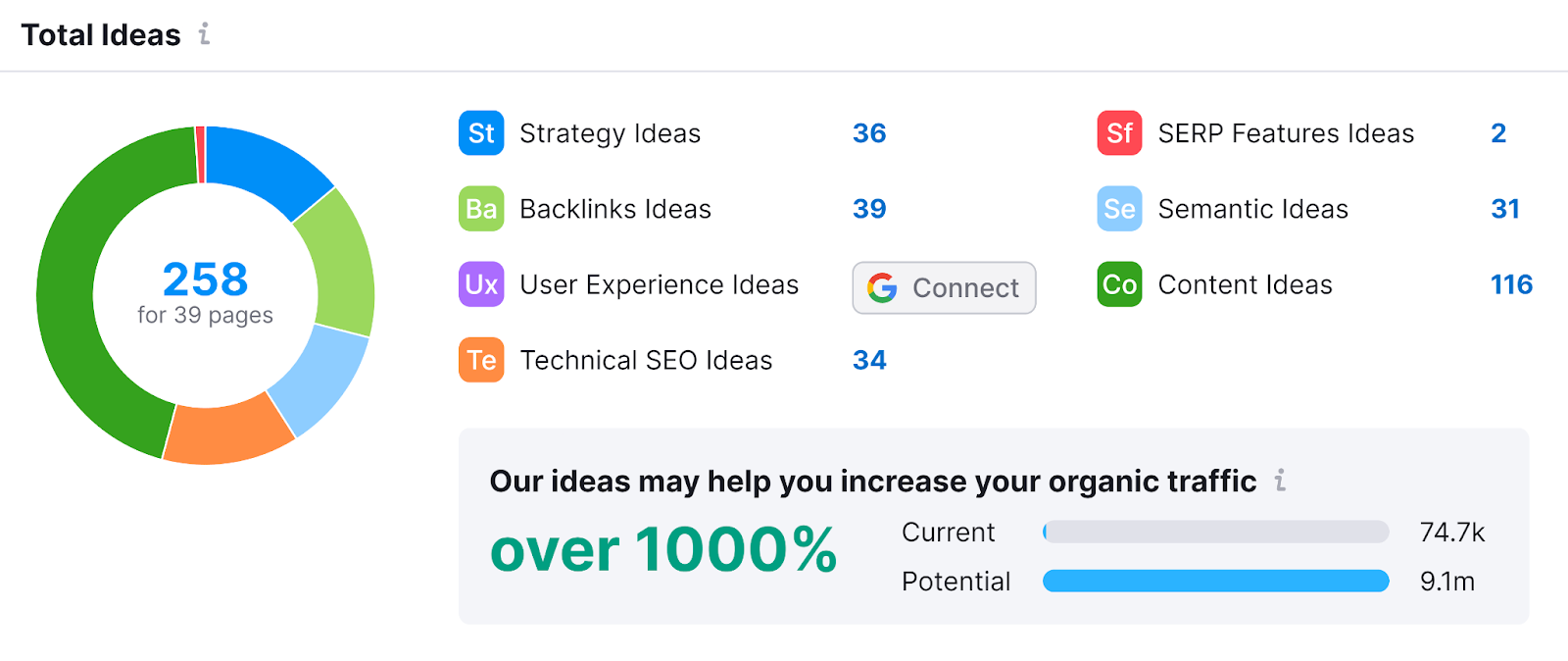
To increase your chances of ranking on Google. And reaching BoFu customers.
Turn Buyers into Loyal Customers
The customer’s journey shouldn’t end after they make a purchase. The bottom of the funnel should also include loyalty and advocacy stages.
A continued relationship with your customers makes them more likely to buy again. And to recommend your brand to others.
This feeds more people into your marketing funnel. Creating an ongoing cycle of sales.
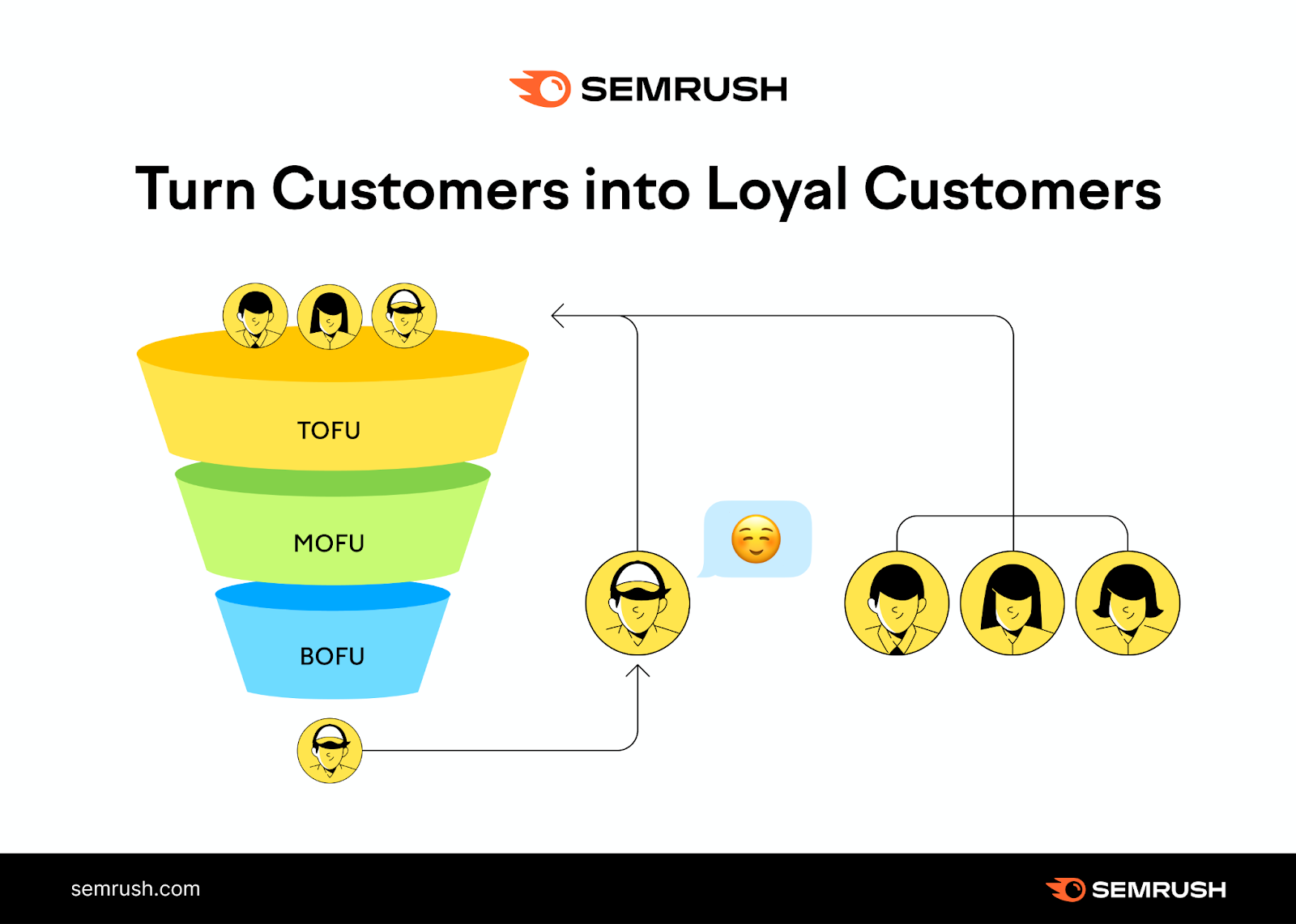
Loyalty and referral programs can play an important role here. They incentivize customers to make repeat purchases and recommend your brand.
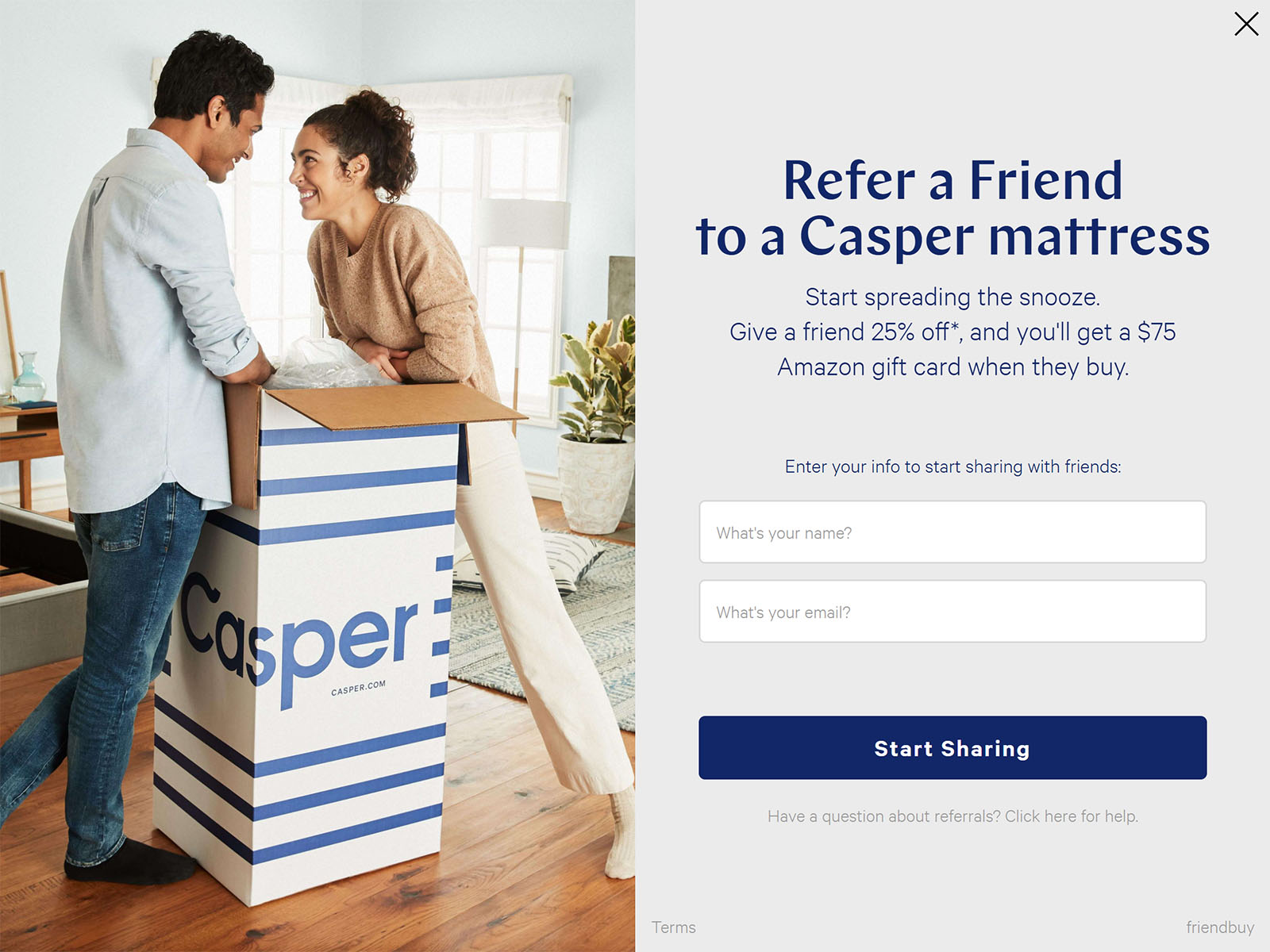
But loyalty programs don’t work for every business.
What you can always provide is great aftercare. Both in the form of customer support and post-purchase content.
Casper’s mattress maintenance guide is a great example. It helps customers get the most out of their purchase. In addition to improving customer satisfaction, it builds trust.
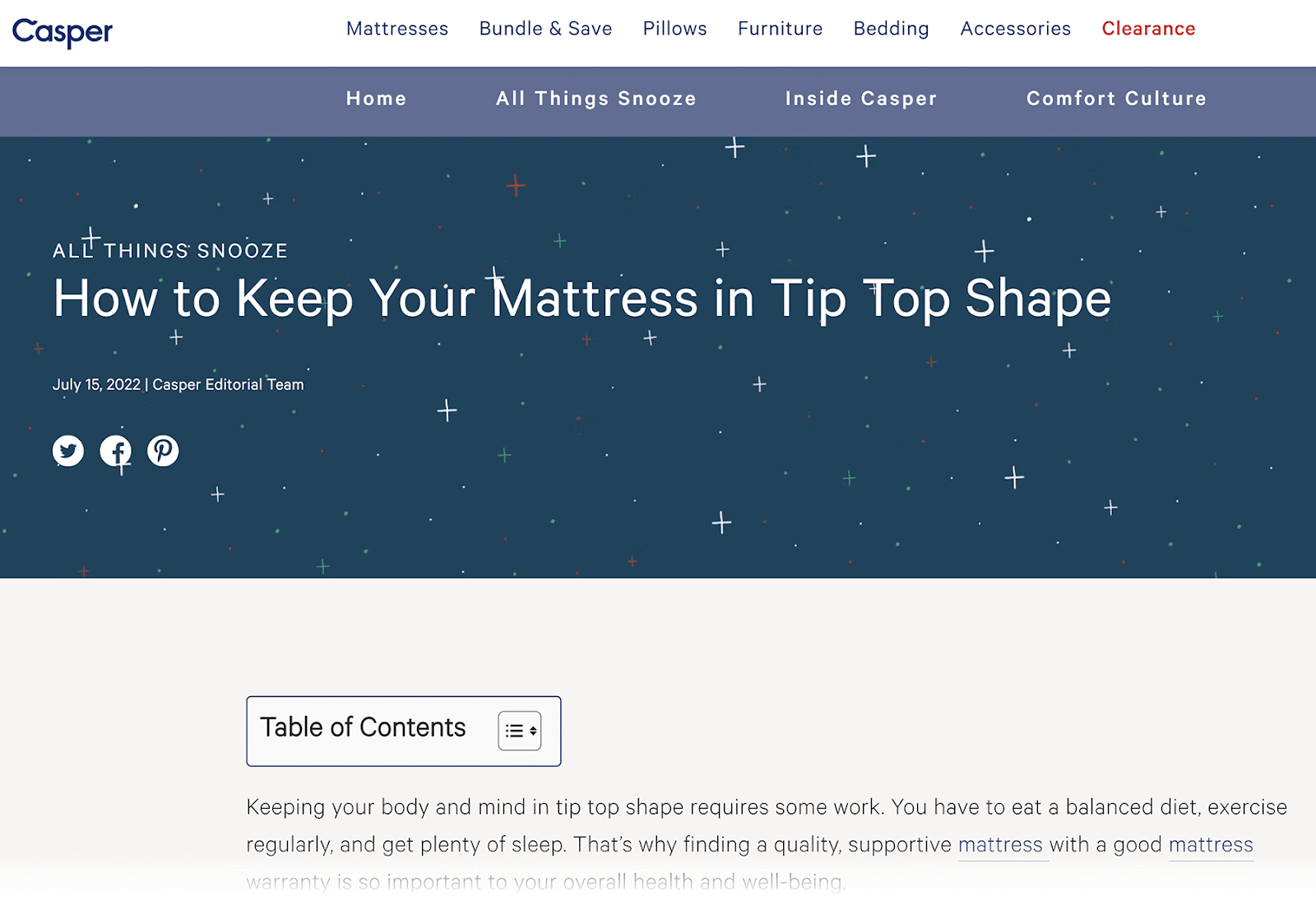
You can also keep previous customers engaged by sharing post-purchase content through social media, email marketing, and other channels.
This keeps your brand on customers’ minds long after they’ve made a purchase.
Marketing Funnel Metrics
When creating your marketing funnel, set goals for each stage. This helps you identify weaknesses and measure growth.
The best approach depends on your strategy. However, these are some of the main marketing funnel metrics:
|
Metric |
Description |
|
|
Top of funnel |
Page views |
How many views your webpages get |
|
Impressions |
How many times your SERP listings or social media posts appear to users |
|
|
Click-through rate (CTR) |
The percentage of impressions that result in clicks |
|
|
Engagement |
The number of interactions with your content |
|
|
Middle of the funnel |
Time on page |
How long visitors spend with your content |
|
Bounce rate |
The percentage of people who land on and leave a page and leave without performing a specified action |
|
|
Google star rating |
Your average rating on your Google Business Profile |
|
|
Bottom of the funnel |
Conversion rate |
The percentage of landing page visits that result in a sale or other conversion |
|
Return on ad spend (ROAS) |
Ad campaign revenue minus ad campaign costs equals ROAS |
You can monitor most marketing funnel metrics through Google Analytics. Check out our Google Analytics guide to learn how.
Create Your Marketing Funnel
Creating a marketing funnel involves more than drawing out a few stages.
You need to think carefully about your target customers—how their needs change as they progress toward purchase and beyond. And how you can cater to them.
But a marketing strategy without data is guesswork. That’s why so many marketers use Semrush.
Semrush’s digital marketing toolkit provides the insights you need to understand your audience and tailor your strategy. Every step of the way. Try it for free today.
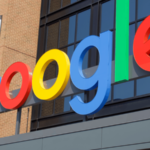


![Email Signature Examples: How to Write a Great One [+ Free Generator]](https://bloggerseo.com.ng/wp-content/uploads/2024/12/email-signature-examples-how-to-write-a-great-one-free-generator-150x60.png)
